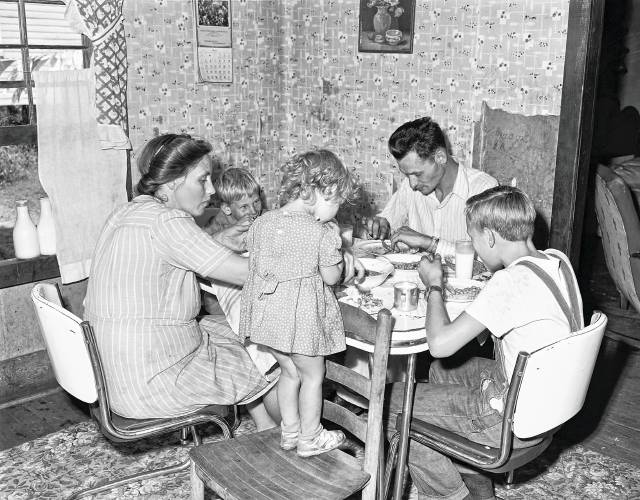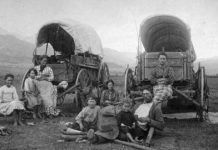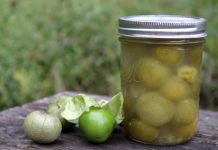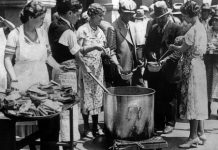The Great Depression brought out both the resiliency and ingenuity of literally millions of people. With few options, people had to make do with what was on hand. Clothes were sewn with spare flour sacks and shoes repaired with cardboard.
Food, however, is where things got really interesting. Some foods were still plentiful and reasonably affordable, but others were scarce. How do you make a full meal when half your ingredients are missing?
You improvise and invent a whole host of crazy foods in the process. Here are some strange meals people ate during the Great Depression–meals we might all be eating again someday.
1. Creamed Chipped Beef
This is also known as sh*t on a shingle, which sums up the thoughts of those that had to eat it. In a nutshell, it’s dried beef that’s re-hydrated a bit in a sauce made with flour and butter, and then served on toast. All you need is some milk, butter, flour, dried beef, and some pepper and parsley.
2. Corned Beef Salad
So corned beef salad doesn’t sound that bad…until you learn that it’s made with mayonnaise and Jello. Well, gelatin anyway. It’s a mixture of corned beef, eggs, mayonnaise, horseradish, and some vegetables, all held together in a loaf with plain gelatin. Yum…beef jello.
3. Dandelion Salad
These days, the foodie movement has just about everyone open to eating foods foraged from your yard, but back then dandelion salad was just weird. They did it because it was a way to get free food onto the table, and a bit of added vitamins in an otherwise bland depression diet.
4. Egg Drop Soup
Not anything like the egg drop soup you can order in modern Chinese restaurants, this soup started with fried potatoes and then added water. The mixture was brought to a boil, and then scrambled eggs were stirred in while the water was boiling. The whole thing was served over toast. I’m not sure why they didn’t just have eggs, potatoes, and toast, but perhaps the spirit of creativity took hold.
5. Frozen Fruit Salad
This particular dish was considered the ultimate treat for the holidays. There are many variations of this salad, but all have the same basic feel. Start with canned fruit and add whipped cream, eggs, flour, and any manner of other things (marshmallows, nuts, or whatever is available). Freeze the whole thing in trays and then serve.
6. Great Depression Casserole
During the Great Depression, many people couldn’t afford meats like beef and chicken. So instead, bologna became a common staple. This casserole takes advantage of that by using bologna as the main ingredient. It might not sound that great, but by the time you add chili, cheddar, peppers, garlic, onions, and pork and beans, it becomes absolutely mouth-watering.
7. Hoover Stew
Named after the president that took office right before the crash, Hoover Stew was the name for the cheap slop eaten by residents of shantytowns. Recipes vary, but usually involved hot dogs, canned vegetables, and pasta or macaroni.
8. Ketchup, Mayonnaise or Onion Sandwiches
What do you do when you want a sandwich, but don’t have any meat or cheese to put in it? Put some ketchup between slices of bread and call it good. Mayonnaise sandwiches were also common, and honestly sound a lot better than the last option, plain onion sandwiches.
- Recipe: Put ketchup, mayonnaise, or onion between two slices of bread. Eat.
9. Kraft Mac and Cheese
This one isn’t very strange, but we included it because it was invented during the Great Depression. Kraft mac and cheese was advertised as an exercise in frugality. These days it’s commonplace, and it’s still a cheap way to put calories on the table, but back then a shelf-stable box with powdered cheese replaced a traditional homemade meal full of expensive ingredients like cheese and cream.
10. Meatless Meatloaf
These days, meatloaf is a simple and relatively cheap weeknight dinner. But how do you make it without ground beef? That’s how it became just “loaf” and it was made out of just about anything put into a loaf pan. Cheap foods like liver, peanuts, and raisins found their way into this catch-all food.
11. Milkorno
Invented by scientists at Cornell University in 1933 when they were looking for inexpensive ways to feed the masses, it’s a gruel made from dried powdered milk and cornmeal. Other variations like milkwheato (using wheat instead of corn) were also invented and were just as appetizing.
12. Mulligan Stew
This stew was invented by the homeless. They would put a big pot over a campfire, and everyone would contribute whatever food they had on hand—-meat, potatoes, bread, onions, rice, tomatoes, and so forth. Sometimes they would even add lint or sawdust to make it more filling.
13. Mock Apple Pie
How do you make an apple pie without apples? It turns out there are a number of ways. One popular recipe involved stuffing a pie crust with Ritz and then covering them with cinnamon, butter, and sugar syrup. Other recipes substitute fruits or vegetables, like this mock apple pie made with zucchini.
14. Peanut Butter Stuffed Onions
Actually recommended by home economics teachers, peanut butter stuffed baked onions found its way onto tables during the Great Depression. Basically, you just bake an onion, then scoop part if it out, and replace with a scoop of peanut butter. You won’t be surprised when I tell you it wasn’t very popular.
15. Poor Man’s Meal
A mixture of hot dogs and potatoes, a poor man’s meal was actually quite tasty. Potatoes were fried with onions until browned, and then chopped hot dogs were added. My grandmother made this for me as a child, and my mother had her own version, substituting kielbasa for the hot dogs, which made it much tastier.
16. Potato Pancakes
Potatoes were one of the most widely available foods, and they found their way into many dishes. Simple potato pancakes are some of the more appetizing ways they were eaten. They were made either by frying mashed potatoes or by binding grated potatoes together with flour and eggs.
17. Prune Pudding
Actually served at the White House as an act of solidarity with “the people who are suffering” in the streets, prune pudding is a simple mix of boiled prunes, sugar, and cornstarch. Sometimes seasoned, sometimes not, prune pudding had to fill in for dessert. It was generally served in small dishes, to prevent disastrous prune related consequences.
18. Red Velvet Cake
These days you can find red velvet cake recipes on fancy food blogs, but back then it was a cheap way to make an “almost” chocolate cake. Substituting vegetable oil for real butter, and using almost no cocoa, what the cake lacked in flavor it made up for in color.
19. Spaghetti with Carrots and White Sauce
Eleanor Roosevelt herself recommended this dish for the frugal cook. It involved a casserole made out of intentionally overcooked mushy spaghetti and boiled carrots, covered in a pasty white sauce made from flour and butter.
20. Vinegar Pie
Though mock apple pie was one option, other pie recipes tried to get a “fruit pie” feel by substituting the tartness of fruit with vinegar. The dessert was made with a pie crust filled with butter, flour, sugar, and vinegar. Sounds horrible to me, but I guess it can’t be that weird, even Martha Stewart has a recipe.





















